
Conifers are a group of cone-bearing seed plants, a subset of gymnosperms. Scientifically, they make up the division Pinophyta, also known as Coniferophyta or Coniferae. The division contains a single extant class, Pinopsida. All extant conifers are perennial woody plants with secondary growth. The great majority are trees, though a few are shrubs. Examples include cedars, Douglas-firs, cypresses, firs, junipers, kauri, larches, pines, hemlocks, redwoods, spruces, and yews. The division Pinophyta contains seven families, 60 to 65 genera, and more than 600 living species.

Choristoneura fumiferana, the eastern spruce budworm, is a species of moth of the family Tortricidae native to the eastern United States and Canada. The caterpillars feed on the needles of spruce and fir trees. Eastern spruce budworm populations can experience significant oscillations, with large outbreaks sometimes resulting in wide scale tree mortality. The first recorded outbreaks of the spruce budworm in the United States occurred in about 1807, and since 1909 there have been waves of budworm outbreaks throughout the eastern United States and Canada. In Canada, the major outbreaks occurred in periods circa 1910–20, c. 1940–50, and c. 1970–80, each of which impacted millions of hectares of forest. Longer-term tree-ring studies suggest that spruce budworm outbreaks have been recurring approximately every three decades since the 16th century, and paleoecological studies suggest the spruce budworm has been breaking out in eastern North America for thousands of years.

Otiorhynchus ovatus, the strawberry root weevil, is one of the many species in the weevil family (Curculionidae), occurring across Canada and the northern United States. The species was first described by Carl Linnaeus in his landmark 1758 10th edition of Systema Naturae. Its name comes from its affinity for strawberry plants, which form a large part of its diet. They are, however, known to feed on other plants as well. Occasionally the larvae cause serious damage to seedlings and young transplants in plantations and nurseries. It is known to be one of the major pests threatening sub-tropical strawberry farming.
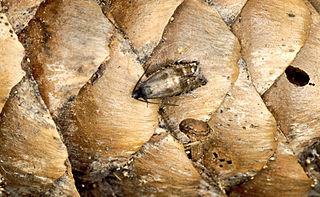
Cydia strobilella, the spruce seed moth, is a moth of the family Tortricidae. It is found in Europe.
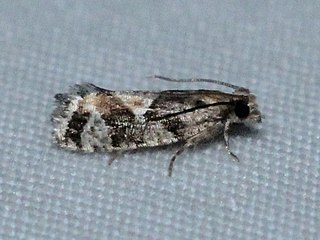
Zeiraphera canadensis, the spruce bud moth, is a moth of the family Tortricidae. It is a small brown moth mainly found in North America, specifically New Brunswick, Quebec, and the north-eastern United States. The adult moth flutters quickly, and stays low among trees during the day and higher above tree cover after sunset. The spruce bud moth relies primarily on the white spruce tree as a host plant. Both male and female spruce bud moths mate multiply, however males have the ability to secrete accessory gland proteins that prevent female re-mating. The moth is univoltine, meaning only one generation hatches per year, and its eggs overwinter from July to May. The species Z. ratzeburgiana is very similar to Z. canadensis and can only be distinguished by the presence of an anal comb in Z. canadensis.

Protoboarmia porcelaria, the porcelain gray or dash-lined looper, is a Geometrid species of moth found throughout North America, except in the far north. The species was first described by Achille Guenée in 1857.

Epinotia nanana, the European spruce needleminer, is a moth of the family Tortricidae. It is found from northern and central Europe to Russia and Mongolia.

Coleotechnites gibsonella is a moth of the family Gelechiidae. It is found in the north-eastern parts of the United States and Canada. The type specimen was found in Hull, Quebec in 1905 by Arthur Gibson.

The orange larch tubemaker is a moth of the family Gelechiidae. It is found in the north-eastern parts of the United States, as well as Canada.

The brown hemlock needleminer is a moth of the family Gelechiidae. It is found in the north-eastern parts of the United States, as well as Canada.
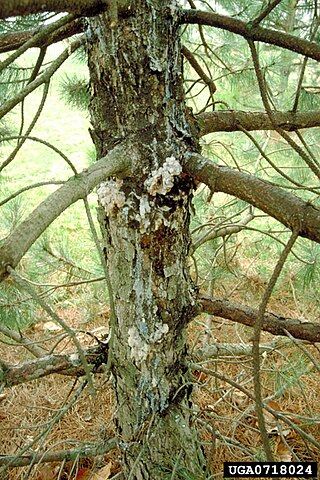
Synanthedon pini, the pitch mass borer, is a moth of the family Sesiidae. The pitch mass borer occurs on spruce and pine in eastern North America. It does not kill trees, but the pitch-filled larval tunnels in the wood cause defects in the lumber.
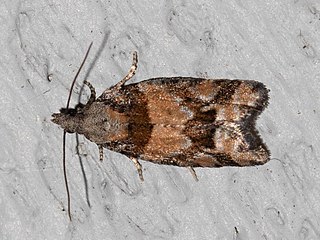
Epinotia radicana, the red-striped needleworm moth, is a species of moth of the family Tortricidae. It is found in western Canada, including British Columbia and Alberta.
Argyresthia picea is a moth of the family Yponomeutidae. It is found in Canada, including Alberta, Ontario, Quebec and the Yukon.
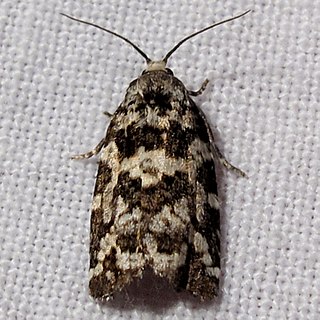
Archips packardianus, the spring spruce needle moth or spruce needleworm, is a species of moth of the family Tortricidae. Spruce needle worms are commonly found in small numbers on spruce and trees of other coniferous genera throughout most of Canada and the northeastern US. Archips packardiana overwinters as a tiny larva in a mined needle. Needle mining is resumed in the spring, the larvae later moving to feed on new foliage, where they spin considerable webbing. Full-grown larvae have a pale green head, sometimes patterned with brown, and a pale body and pale thoracic legs, and are about 20 mm long. The larva pupates, usually in the webbed needles, and the adult emerges in summer to early fall. The closely related Archips strianus is much less common, but probably has a habitat similar to that of A. packardiana. The larvae have dark thoracic legs and small dark areas around the base of the thoracic hairs. The habitat consists of coniferous and mixed woods.

Gilpinia hercyniae, the European spruce sawfly, was first found in North America near Hull, Quebec, in 1922. By 1930, severe damage was occurring in spruce stands in the Lower St. Lawrence–Gaspé region of Quebec. Population levels exploded, and further damage subsequently occurred in New Brunswick and the northeastern United States. Loss of wood from spruce mortality was estimated at 10 million cubic metres, but by the mid-1980s pest numbers on all species of spruce in Canada from Manitoba to the Atlantic Ocean and in adjacent parts of the United States had become relatively low under the influence of spontaneous virus disease and introduced parasites. In Newfoundland, control was helped by the introduction of the masked shrew, a cocoon-hunting insectivore.
Spruce sawflies are various sawfly species found in North America that feed on spruce. There are multiple species of sawflies known as spruce sawflies, including species in the genera Gilpinia, Pikonema, Pristiphora, and Cephalcia. Each kind of sawfly attacks particular parts of the spruce as larvae during different times of the year.
Coleotechnites ducharmei is a moth of the family Gelechiidae. It is found in North America, where it has been recorded in south-western Nova Scotia, southern Quebec, Ontario, and Alberta.
Coleotechnites resinosae, the red pine needleminer moth, is a moth of the family Gelechiidae. It is found in North America, where it has been recorded from Ontario, Alabama and New Hampshire.
Elatobium abietinum, commonly known as the spruce aphid or green spruce aphid, is a species of aphid in the subfamily Aphidinae that feeds on spruce, and occasionally fir. It is native to Northern, Central and Eastern Europe and has spread to Western Europe, North America and elsewhere.

Nalepella, the rust mites, is a genus of very small Trombidiform mites in the family Phytoptidae. They are commonly found on a variety of conifers, including hemlock, spruce, balsam fir, and pine. They sometimes infest Christmas trees in nurseries. Nalepella mites are vagrants, meaning they circulate around the tree; females overwinter in bark cracks. Infested spruce emit a characteristic odour.


















